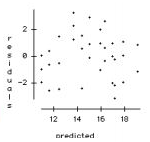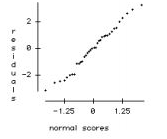For a class project, students tested four different brands of laundry detergent (1, 2, 3, 4) in
three different water temperatures (hot, warm, cold) to see whether there were any
differences in how well the detergents could clean clothes.The students took 36 identical
pieces of cloth and made them dirty by staining them with coffee, dirt, and grass.The 36
pieces were randomly assigned to the 12 combinations of detergent and temperature so
that each combination had 3 replicates.After washing, the students rated how clean the
clothes were from 0 (no change) to 20 (completely spotless).The two factor ANOVA
table is shown below along with an interaction plot and residual plots. 
a. Write the hypotheses tested by the Detergent -ratio. Test the hypotheses and explain your conclusion in the context of the problem.
b. Write the hypotheses tested by the Temp -ratio. Test the hypotheses and explain your conclusion in the context of the problem.
c. Check the conditions required for the ANOVA analysis.
Definitions:
Customer Purchases
Transactions where consumers buy goods or services from businesses, exchanging money for products.
Excessive Inventory
A larger amount of stock than what is needed, leading to unnecessary storage costs and potential obsolescence.
Demand Volatility
The degree to which demand for a product or service can fluctuate unpredictably over a certain period, affecting supply chain and inventory management strategies.
Safety Inventory
Inventory kept as a buffer against forecasted demand and supply variability to prevent stockouts.
Q1: Is <span class="ql-formula" data-value="\log _
Q5: An organization's culture may not always be
Q10: A sample of 33 companies was
Q10: Use O-notation to express the following
Q11: <span class="ql-formula" data-value="\text { Prove that if
Q17: In 2014 , the average math
Q18: A company's manufacturing process uses 500 gallons
Q21: One of the characteristics of leaders who
Q28: How many different license plates can be
Q49: Freddie is the head of operations of